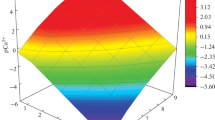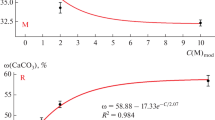Summary
The solubility of cholesterol in aqueous solutions of bile salts and lecithin with N/10 phosphate buffer, pH 7.3 has been examined.
For the sodium salts of the six bile acids used in the study, the capacity for dissolving cholesterol was found to decrease in the following order: Glycodeoxycholate, Taurodeoxycholate, Glycochenodeoxycholate, Taurochenodeoxycholate, Glycocholate, Taurocholate.
The differences with respect to cholesterol dissolving capacity were greatest when no lecithin was present, and decreased as the amount of lecithin increased.
Graphical representations (molar ratio bile salt to cholesterol as abscissa, molar ratio lecithin to cholesterol as ordinate) of the limits for solubility of cholesterol in 100 millimolar solutions of each of the six bile salts to which purified egg lecithin is added in amounts varying from zero to approximately 80 millimoles per 100 millimoles bile salt, had the shape of curved lines tending to converge against a point, approximately 3.5, on the vertical axis but without reaching it. (Fig. 1). The starting points of the curves on the horizontal axis (millimoles bile salt required to dissolve 1 millimole of cholesterol in the absence of lecithin) were: for Glycodeoxycholate 19, for Taurodeoxycholate 30, for Glycochenodeoxycholate 34, for Taurochenodeoxycholate 47, for Glycocholate 52, for Taurocholate 62.
The graphical representation, as above, of the limit for solubility of cholesterol in a 100 millimolar solution of a mixture of the six bile salts in relative amounts as in human bile, to which lecithin from human bile is added was practically identical to the corresponding curve for a 100 millimolar solution of glycochenodeoxycholate with additions of purified egg lecithin (Fig. 2.).
The starting point on the horizontal axis for the curve representing mixed bile salts could be calculated — with fair approximation — from the cholesterol dissolving capacities of the individual bile salts in the mixture.
The graphical representations of the limits for solubility of cholesterol in 50 millimolar, 100 millimolar and 200 millimolar aqueous solutions of sodium taurodeoxycholate to which purified egg lecithin was added in varying amounts did not show any certain differences from each other.
Two purified egg lecithins of greatly different fatty acid pattern (Table 1) isolated from eggs of hens fed linoleic acid deficient diets and linoleic acid rich diets respectively, did not show any certain difference from each other with respect to cholesterol dissolving capacity when added in varying amounts to a 100 millimolar solution of sodium taurodeoxycholate.
Zusammenfassung
Die Löslichkeit von Cholesterin in wässerigen Lösungen von Gallensäuresalzen und Lecithin, mit N/10 Phosphat-Puffer pH 7.3, wurde untersucht.
Unter den Natriumsalzen der sechs untersuchten Gallensäuren hatte Glycodeoxycholat das höchste Lösungs-Vermögen für Cholesterin. Davon nahm das Lösungs-Vermögen ab in folgender Reihenfolge: Taurodeoxycholat, Glycochenodeoxycholat, Taurochenodeoxycholat, Glycocholat, Taurocholat.
Die Unterschiede in Bezug auf das Cholesterin-Lösungsvermögen waren am größten, wenn die Lösungen kein Lecithin enthielten, sie nahmen ab mit zunehmendem Lecithin-Gehalt.
Graphische Darstellungen (Moläres Verhältnis Gallensäuresalz/Cholesterin als Abscisse, Moläres Verhältnis Lecithin/Cholesterin als Ordinat) der Sättigungs-Grenzen für Cholesterin in 100 millimolären Lösungen jeder der sechs untersuchten Gallensäuresalzen zu welchen chromatographisch gereinigtes Ei-Lecithin in Quantitäten von Null bis ungefähr 80 Millimol per 100 Millimol Gallensäuresalz zugesetzt wurde, erschienen als krumme Linien mit Richtung gegen einen Punkt, ungefähr 3.5, auf der Ordinate, ohne jedoch diesen Punkt zu erreichen (Fig. 1). Die Anfangspunkte der Kurven auf der Horizontalachse (Anzahl Millimol des betreffenden Gallensäuresalz, die nötig sind um 1 Millimol Cholesterin in Lösung zu halten in Abwesenheit von Lecithin) waren: für Glycodeoxycholat 19, für Taurodeoxycholat 30, für Glycochenodeoxycholat 34, für Taurochenodeoxycholat 47, für Glycocholat 52, für Taurocholat 62.
Die graphische Darstellung der Sättigungs-Grenze für Cholesterin in einer 100 millimolären Lösung einer Mischung der sechs Gallensäuresalzen, in Mengenverhältnissen wie in menschlicher Galle, wozu Lecithin aus menschlicher Galle in variierender Menge zugesetzt wurde, war mit der entsprechenden Darstellung der Sättigungs-Grenze für Cholesterin in 100 millimolarer Lösung von Natrium Glycochenodeoxycholat mit Zusatz von chromatographisch gereinigtem Ei-Lecithin praktisch zusammenfallend. (Fig. 2.). Der Anfangspunkt der für gemischte Gallensäuresalze geltenden Kurve auf der Horizontalachse ließ sich aus den Cholesterin-Lösungsvermögen der einzelnen Gallensäuresalzen mit befriedigender Annäherung berechnen.
Die graphischen Darstellungen der Sättigungs-Grenzen für Cholesterin in 50 millimolaren, 100 millimolaren und 200 millimolaren Lösungen von Natrium-Taurodeoxycholat mit variierendem Zusatz von chromatographisch gereinigtem Ei-Lecithin waren nicht mit Sicherheit verschieden von einander.
Zwei Ei-Lecithine von sehr verschiedenem Fettsäuremuster (Tabelle 1) isoliert aus Eiern von Hennen, welche mit linolsäuredeficienten bzw. linolsäurereichen Nahrungen gefüttert worden waren, zeigten keine sichere Verschiedenheit von einander in bezug auf Cholesterin-Lösungsvermögen, wenn dieselben in variierender Menge, einer 100 millimolaren Lösung von Natrium-Taurodeoxycholat zugesetzt wurden.
Similar content being viewed by others
References
Spanner, G. O. andL. Baumann, J. Biol. Chem.98, 181 (1932).
Isaksson, B., On the lipids and bile acids in normal and pathological bladder bile. (Lund 1954).
Small, D. M., M. Bourgés andD. G. Dervichian, Biochim. Biophys. Acta125, 563 (1966).
Hofmann, A. F. andD. M. Small, Ann. Rev. Med.18, 333 (1967).
Neiderhiser, D. H. andH. P. Roth, Proc. Soc. Exp. Biol. Med.128, 221 (1968).
Saunders, D. R. andM. A. Wells, Biochim. Biophys. Acta176, 828 (1969).
Norman, A., Arkiv för Kemi8, 331 (1955).
Hofmann, A. F., The function of bile salts in fat absorption. Thesis, Lund, Sweden, 1964 pp. 41, esp. pp 5–6.
Hofmann, A. F., Acta Chem. Scand.17, 173 (1963).
Singleton, W. S., M. S. Gray, M. L. Brown andJ. L. White, J. Amer. Oil Chem. Soc.42, 53 (1964).
Dam, H., I. Kruse, M. Krogh Jensen andH. E. Kallehauge, Scand. J. Clin. Lab. Invest.19, 367 (1967).
The Merck Index, Eighth Edition 1968, Published by Merck & Co., Inc. Rahway, N. J., U.S.A. p. 253 and p. 615.
Dam, H., I. Kruse, I. Prange, H. E. Kallehauge, H. J. Fenger andM. Krogh Jensen, Z. Ernährungswiss.10, 160 (1971).
Large, A. M., C. G.Johnston, T.Katsuki and H. L.Fachnie, Amer. J. Med. Sci. 1960, 239.
Admirand, W. H. &D. M. Small, J. Clin. Invest. 47, 5, 1043 (1968).
Author information
Authors and Affiliations
Rights and permissions
About this article
Cite this article
Hegardt, F.G., Dam, H. The solubility of cholesterol in aqueous solutions of bile salts and lecithin. Z Ernährungswiss 10, 223–233 (1971). https://doi.org/10.1007/BF02020933
Received:
Published:
Issue Date:
DOI: https://doi.org/10.1007/BF02020933




